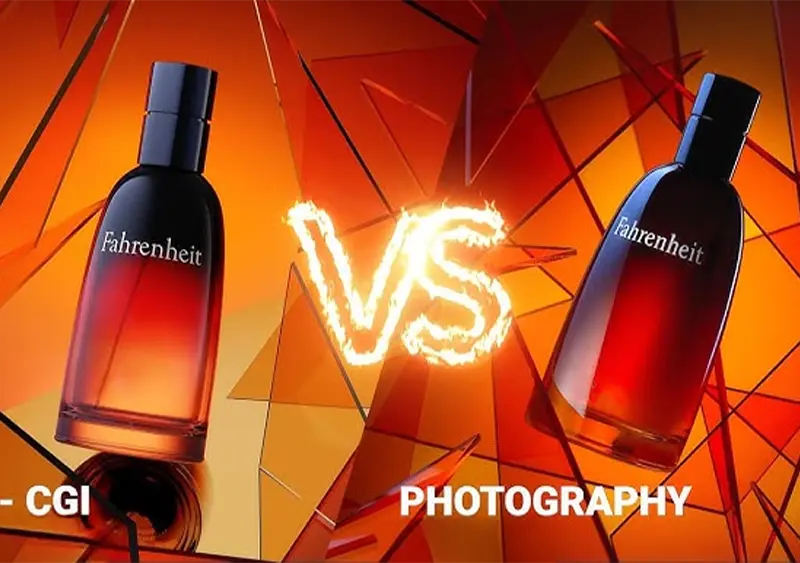3D Rendering vs Photography: Which Is the Better Choice in 2025?
Discover the smarter choice for product visuals in 2025

6 MIN READ
August 18, 2025

Written By
Sasikumar Janakiraman
The question is no longer "should we use photography?" It's now "do we need to?" At Zealous Services, we've watched 3D rendering evolve from a futuristic concept into a powerful, practical business tool. In this post, we'll put these two visual giants head-to-head, breaking down the true costs, hidden efficiencies, and long-term strategic advantages of each to help you future-proof your brand.
What Is 3D Rendering?
3D rendering is the final step in creating a photorealistic image from a digital model. It's the process of generating a high-resolution 2D picture from a virtual 3D asset. Essentially, it transforms a digital blueprint into a stunning, lifelike visual without the need for a physical camera.
Advantages
- Unmatched Flexibility: Create an unlimited number of visuals from any angle or perspective from a single digital model.
- Significant Cost Savings: Drastically reduce costs associated with travel, logistics, and physical prototypes for product variations.
- Faster Time-to-Market: Generate new visuals on demand, allowing for quicker campaign launches and product updates.
Limitations
While the long-term benefits are substantial, 3D rendering does require a skilled 3D artist and a notable upfront time investment to create the initial, detailed digital model. The complexity of the project can sometimes make the initial setup longer than a traditional photo shoot.
While 3D rendering does come with certain limitations, understanding the process makes it easier to weigh the benefits against the challenges. To dive deeper, check out our detailed guide on how 3D rendering works and see the step-by-step journey from model to final image.
What Is Product Photography?
Product photography is the art of capturing a physical product using cameras, lighting, and real-world settings. It's a traditional and well-established method for creating visuals that showcase the product as it exists in the physical world. The process involves staging the product, carefully arranging professional lighting, and meticulously capturing a high-quality, high-resolution image.
Advantages
- Undeniable Authenticity: Photography provides a level of real-world detail and texture that builds immediate trust with the consumer.
- Quick for Single Products: For an existing product with a single style, a photo shoot can often deliver a polished hero shot very quickly.
- Minimal Setup for Experts: For seasoned professionals with a studio and physical product on hand, the process is streamlined and efficient.
Limitations
The main challenge with traditional photography is its inherent lack of flexibility. Any changes, such as a new color, a different material, or an alternate angle, require a complete reshoot, which means added time and cost. The process is also highly dependent on logistics, as you must have a physical sample and a skilled photographer in the same location. This makes scaling a product line with many variations both expensive and time-consuming.
For a detailed breakdown, check out our full guide on Product Photography vs 3D Modeling.
Side-by-Side Comparison: 3D Rendering vs. Photography
|
Feature |
3D Rendering |
Photography |
|
Realism |
Achieves photorealism that is virtually indistinguishable from a real photo with skilled artists and advanced software. Can create perfect, ideal versions of a product. |
100% accurate to the real product. Captures authentic textures, imperfections, and lighting that can feel more organic and trustworthy. |
|
Cost |
A significant one-time investment in a digital asset. The cost per image or variation drops dramatically to nearly zero after the initial modeling is complete. |
Ongoing and transactional. Each shoot, reshoot, or variation requires new expenses for a photographer, studio, and logistics. It is cheaper for a single product with no variations. |
|
Time to Produce |
Faster after the initial model is complete. Once the digital asset exists, a new visual can be generated within hours, which is ideal for a fast-paced content pipeline. |
Slower and less scalable. The process involves scheduling, shipping physical products, and post-production, which can take days or weeks for a single visual. |
|
Flexibility |
Unlimited. A single digital model allows for infinite changes to angles, backgrounds, lighting, and materials without any reshoots. Can show products in environments that don't exist in the real world. |
Very limited. Creative changes, new angles, or different backgrounds require a new photo shoot. It is bound by what can be physically created and captured in the real world. |
|
Product Needed |
Not required. Visuals can be created before a product has been physically prototyped or manufactured, allowing for pre-sales marketing. |
Required. A physical product, and often a team, must be on hand for the duration of the shoot. |
|
Revisions |
Easy and cheap. Simply open the file and adjust the digital model or its virtual environment. A new render can be completed quickly with minimal cost. |
Expensive and time-consuming. Any significant change requires a new shoot, which means a new budget, scheduling, and logistics, making revisions a costly bottleneck. |
When to Choose 3D Rendering?
1. For Products Still in the Design Stage.
If your product is still in development, 3D rendering allows you to create incredibly realistic visuals long before a physical prototype exists. You can effectively market a concept, secure investment, or get a head start on your sales funnel.
2. When You Need Multiple Variations.
For product lines with many colors, materials, or configurations, 3D rendering is the most efficient choice. Once a single digital model is created, generating dozens of new visuals is a simple, cost-effective process.
3 . For Marketing Before Production.
With rendering, you can create a full e-commerce page, social media campaign, or brochure without waiting for manufacturing to complete. This gives you a competitive edge by allowing you to gather market feedback and even take pre-orders before your product is physically ready.
Cost Comparison in 2025
Understanding the financial impact of each option is critical. While 3D rendering has a higher initial entry point, its long-term cost-effectiveness for scalable projects is where it truly shines. Photography, on the other hand, is a more straightforward transactional cost.
Here is a factual comparison of average costs in 2025:
|
Complexity Level |
Avg. 3D Rendering Cost (USD) |
Avg. Photography Cost (USD) |
|
Simple Products |
$50–$250 per image. Lower end for basic, white-background images. The initial model is reusable for future images. |
$150–$350 per image. A flat fee for a single product includes basic lighting, props, and editing. Costs are per-item and per-angle. |
|
Complex Products |
$300–$1,000+ per image. The higher cost reflects intricate details, advanced texturing, and complex lighting. However, this is a one-time cost for the digital asset, which can then be reused. |
$300–$800+ per image. Requires specialized equipment, advanced lighting setups, and more time. Costs can escalate quickly with multiple angles, variations, or reshoots. |
Final thoughts
As we look to 2025, the choice isn't about which technology is superior, but which one is right for the job. 3D rendering has earned its place as a powerhouse for scalability and pre-production marketing, giving you the flexibility to create endless variations with speed.
Photography, however, will always be the champion of tangible realism. Its unique ability to capture genuine authenticity builds a level of trust that no other medium can.
The most innovative brands are embracing a hybrid strategy. They leverage the digital efficiency of rendering to build a comprehensive visual library, and then use the undeniable authenticity of photography for high-impact, emotional brand storytelling. By combining both, you get a visual strategy that is both scalable and compelling.
At Zealous Services, we understand the stakes. Whether you need the digital efficiency of 3D rendering or the undeniable authenticity of professional photography, we can help you find the right path.
About the writer :
Sasikumar Janakiraman, as the Creative Director at Zealous Services, brings a unique mix of creativity and technical ... skill. He’s passionate about 2D and 3D design, leading teams to create stunning 3D models and visualizations. Sasikumar loves working closely with clients, making sure their ideas come to life in the best possible way. His goal? To make design feel simple and exciting.
Read MoreFrequently Asked Questions (FAQ)
Is 3D rendering cheaper than photography?
In the long run, yes, especially for products with multiple variations or frequent updates. While the initial setup for 3D rendering can be a significant investment, the cost per image drops dramatically after the first digital model is created. Photography costs are ongoing and transactional for every new shot.
Is 3D rendering as realistic as a photograph?
With modern software and skilled artists, yes. Today's 3D renders can achieve a level of photorealism that is virtually indistinguishable from a real photograph. The technology allows for precise control over lighting, materials, and textures to create a flawless, hyper-realistic image.
Which option is faster?
While the initial setup for a 3D rendering project may take longer, the speed of generating a high volume of new visuals is far faster than a photo shoot. Once the digital asset is ready, a new image can be produced in minutes.
Can I use 3D rendering for lifestyle shots?
While it's possible to create virtual environments, it's often best to use traditional photography for shots that include people or real-world interactions. Photography excels at capturing the organic, emotional connection of a lifestyle shot.
What is the best option for a new product launch?
For a product still in the design phase, 3D rendering is the clear winner, as it allows you to create visuals for marketing and pre-sales before the product is physically produced. For products that already exist, the decision depends on your need for scale versus authentic realism.